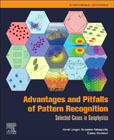
Pattern Recognition: Application in Geosciences
Langer, Horst
Falsaperla, Susanna
Hammer, Conny
Advantages and Pitfalls of Pattern Recognition: Selected Cases in Geophysics highlights the advantages of pattern recognition and classification methods, while also examining potential pitfalls and failures that can arise. Scientific and technological progress has led to a new perspective of data analysis and the requirement of specific techniques, which have to take into account several features rather than a single parameter. The handling of such data is a typical problem of multivariate analysis, and pattern recognition techniques offer a suitable key for the processing and extraction of useful information. Presenting various methods of pattern recognition and classification, Advantages and Pitfalls of Pattern Recognition investigates both supervised techniques, such as linear discrimination, and unsupervised techniques including various concepts of clustering. All approaches are extensively discussed, including example applications and an introduction to available software packages. Part of the Computational Geophysics series, this volume provides computational examples and methods for effectively solving geophysical problems in a full cycle manner. It comprises the formulation of the problem, the choice of suitable features and strategies and a discussion of the results, making it an ideal reference for researchers looking to apply these techniques to their field of geophysics. Offers real-world examples of techniques for pattern recognition and handling multivariate data from a variety of geophysical fieldsIncludes examples of applications and diagrams to enhance understanding of pattern recognition techniquesProvides an introduction to relevant software packages, such as TREmOREC and KKAnalysis INDICE: Part I: Supervised Techniques 1. A Simple Example 2. Solving the XOR Problem 3. Support Vector Machine (SVM) 4. Hidden Markov Models (HMM) Part II: Unsupervised Techniques 5. Metric 6. Clustering 7. Clustering Related to Irregular Shapes 8. Self-organizing Map (SOM) Part III: Example Applications 9. Supervised 10. Unsupervised Part IV: A Posteriori Analysis 11. Performance 12. Problems with Features 13. Test Issues 14. Generative Approaches 15. What is a Failure? Part V: Available Software Packages Appendix: Available Example Data Sets
- ISBN: 978-0-12-811842-9
- Editorial: Elsevier
- Encuadernacion: Rústica
- Páginas: 350
- Fecha Publicación: 01/09/2019
- Nº Volúmenes: 1
- Idioma: Inglés
